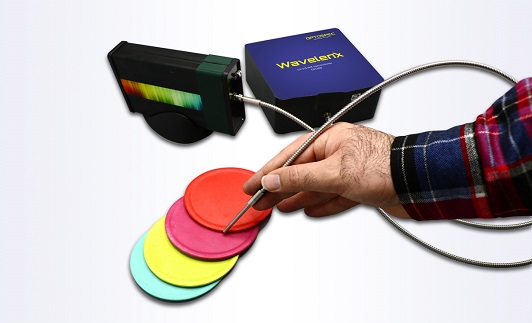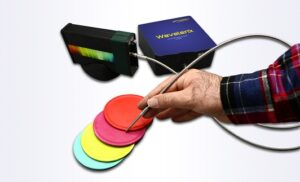Introduction
A spectrometer is a device used to measure the characteristics of light in a specific region of the electromagnetic spectrum. Such devices are typically employed for the analysis of substances. Optical spectrometers are categorized into three groups based on their functionality:
- Fourier-transform spectrometers: In these spectrometers, a Michelson interferometer is employed to measure the oscillations in the signal interference as one of the mirrors moves. The interference function is digitally processed to obtain the desired spectrum. These spectrometers are primarily utilized for infrared spectrum measurements and offer excellent spectral resolution.
- Single-wavelength spectrometers: In these spectrometers, a rotating diffraction grating is used. These spectrometers are simpler and have lower sensitivity to the environment. The Czerny-Turner optical layout is commonly used in the construction of these devices (the layout is explained further below).
- Spectrometers based on multichannel detectors: In these spectrometers, there is no moving element. The diffraction grating is fixed, and the spectrum is focused onto a detector, typically using a CCD detector. Spectrometers in this category vary significantly in terms of sensitivity, spectral resolution, applications, size, and price.
To construct a spectrometer, it is essential to focus on the following points outlined below.
- The spectrometer’s spectral resolution should be less than 5 nanometres.
- No moving components should be used.
- The device and software should be user-friendly and easy to use.
- The provided software should be compatible with most major operating systems.
- Apart from initial calibration, it should require minimal maintenance. Each device stores calibration data in its permanent memory, eliminating the need for frequent recalibration.
- The device should be powered through a USB cable connected to a computer. Now that you are familiar with the basics of constructing a spectrometer, let’s examine the components that make up a spectrometer.
The constituent components of a spectrometer
A spectrometer consists of three main components, namely:
- Slit
- Diffraction grating
- Detector

The basic operation of a spectrometer is as follows: Light enters the device through a slit. It is then directed towards the diffraction grating by optical elements. The grating disperses the light into its constituent wavelengths. Finally, the dispersed light is focused onto the detector by mirrors and lenses. Now that you are familiar with how a spectrometer works and its components, let’s move on to the functions of each of these elements.
The slit
The slit controls the amount of incoming light (photon flux) and the spectral resolution. Increasing the width of the slit enhances the optical power for analysis and reduces the time needed for spectroscopy. However, it’s crucial to note that as the slit width increases, the device’s resolution decreases. Conversely, narrowing the slit width extends the spectroscopy time. Therefore, the slit width needs to be selected optimally. For example, consider the absorption spectrum of holmium oxide. By changing the slit width, the spectral resolution is also adjusted. This process is illustrated in Figure 2.

Spectrometers use a wide variety of slits. The slit widths can range from 5 micrometers to a maximum of 800 micrometers, and their heights typically vary between 1 to 2 millimeters (with a standard height of 1 millimeter). The most common slit widths used in spectrometer construction are 10, 25, 50, 100, and 200 micrometers.
This element must be precisely positioned in the optical path to allow light to pass through it completely. Otherwise, any misalignment in the path can introduce errors and increase device noise. For this reason, changing the slit after installation should only be done by experts to avoid complications in the device’s calibration.
The diffraction grating
The diffraction grating is another essential component used in the construction of a spectrometer. It determines the wavelength range and optical resolution. This element disperses light into its constituent wavelengths. In fact, each wavelength is scattered at a specific angle.
There are two types of diffraction gratings: holographic gratings and ruled gratings. Ruled gratings are mechanically created with parallel grooves on a substrate, which are then coated with highly reflective materials such as gold. Holographic gratings, on the other hand, are formed through the interference of two laser beams on a responsive material, where the refractive index of the material periodically changes. The production process for holographic gratings is distinct. However, the most common method for producing these gratings is to expose a glass substrate to ultraviolet light. This exposure leads to changes in the refractive index of the material. Ruled gratings separate wavelengths using grooves, whereas holographic gratings separate wavelengths by sinusoidal changes in the refractive index. Holographic gratings achieve much higher angular dispersion due to the very close spacing of sinusoidal refractive index changes. They can also be used on curved surfaces. It’s important to note that holographic gratings absorb in the infrared region and are more expensive than other types of gratings. Both types of gratings operate on the principles of diffraction and are based on the phenomenon of scattering.


The groove frequency
The degree of dispersion is determined by the number of grooves per millimeter, known as groove frequency or groove density. The groove frequency specifies the range of wavelengths covered by the spectrometer in terms of spectral length. Additionally, the spectral resolution is determined by the groove frequency. The wavelength range covered by the spectrometer is inversely related to the angle of diffraction of the grating. In other words, as the groove frequency increases, the diffraction angle also increases, leading to a reduction in the wavelength range covered by the spectrometer. On the other hand, the system’s resolution increases. For instance, consider a grating with a groove frequency of 900 grooves per millimetre (900 g/mm). The wavelength range detectable by the device is approximately 370 nanometres, and its resolution is 0.5 nanometres. Now, if the groove frequency is reduced to 600 g/mm, the wavelength range expands to 700 nanometers, but the resolution becomes 1 nanometre. As you can see, while the wavelength range has increased, the resolution has decreased. This is a fundamental principle that applies to all spectrometers.
The detector
In the previous sections, we discussed the importance of the slit and diffraction grating in a spectrometer. The final element in the optical system of any spectrometer is the detector. An optical detector is a device that absorbs optical energy and converts it into electrical energy, or in another scenario, the optical current is stored as charge and then transferred to the readout circuit (such as CCDs). The electrical current generated or the stored charge is directly proportional to the incident optical power. The type of detector used in a spectrometer depends on the method used for wavelength analysis. The following methods are explained below.
The Rotating Grating Method: In this method, a small area optical detector, usually referred to as a point detector, is used. In this case, the diffraction grating is movable and rotates, focusing a specific wavelength onto the detector each time. Essentially, the processing elements assign the wavelength to an electrical signal based on the angle of diffraction of the grating.
The Array Detector Method: In this method, regular arrays of optical detectors are placed alongside each other. In this configuration, an array comprises a row of optical detectors, each detecting a specific range of wavelengths focused on the array. CCDs are a suitable example of this type of detector.
DLP-based Method: The DLP-based method is a new approach used for wavelength analysis. This method offers superior performance compared to traditional methods.
DLP stands for Digital Light Projection. The new method works by using a digital micromirror device (DMD) instead of an array or scanning detector. A DMD is an array of mirrors created using MEMS (Micro-Electro-Mechanical Systems) technology. In this technology, the angle of each mirror can be adjusted to either direct light towards the detector or away from it. These mirrors are electronically controlled through a DLP control page. This method is similar to the array detector approach, but instead of using an array detector, it employs a DMD. In this setup, light is dispersed by the grating, and then the dispersed light is focused onto the DMD using a lens. By adjusting the tilt of individual mirrors on the DMD (each responsible for reflecting a specific wavelength), light of a particular wavelength is directed towards the detector. In this system, point detectors are used to detect the wavelengths. Larger area point detectors can be utilized in this approach, since the dimensions of the mirrors are responsible for wavelength separation. This method represents a very innovative approach that enhances resolution and analysis speed.

In the previous section, we discussed the methods by which we could identify wavelengths. However, the main topic is the types of detectors that can help us convert these wavelengths (optical signals) into electrical signals. In an ideal scenario, a detector should have low noise, high sensitivity, and a linear response over a wide range. Spectrometers commonly use photodiode array detectors and CCD detectors. This topic is thoroughly described in the detector section. Therefore, in the next section, we will discuss how light is directed toward the detector after scattering. Since most spectrometers are built based on CCD detectors, we will also explain the next section using CCD as an example.
How scattered light is focused onto the CCD detector
Light is scattered after hitting the diffraction grating. Scattered light can be focused onto the detector using three methods. In the first method, a lens directs the light towards the detector. This system is illustrated in Figure 5. The components making up the light are separated at different angles using the grating (angular separation). The lens converts this angular separation into spatial separation. However, this method requires a lens with a diameter equal to the length of the CCD. The spatial separation of wavelengths is proportional to the lens’s focal length. In this way, the dispersed light is focused onto the detector. In the second method, after the light is dispersed, the wavelengths directly collide with the detector. In this case, no second lens is required. The first lens is placed a few millimeters away from the slit to create a real image at a desired distance from the grating (Figure b). This lens is adjusted in such a way that the separated wavelengths converge onto the detector. In this method, the detector is actually placed at the focal point of the lens. However, the image obtained from this method is slightly blurry because the angular differences of the separated wavelengths are non-uniform. In the third method, a curved or cylindrical mirror is used to focus the dispersed light. In this case, there is no need for the detector to be located at the lens’s focal point. In fact, the detector is placed near the mirror and at its focal length. In this case, the device’s sensitivity increases. Therefore, the third method is used to build spectrometers.

As mentioned in previous discussions, light enters the spectrometer through the slit. It then interacts with the grating, where it is dispersed into its constituent wavelengths. The dispersed light is finally detected using a detector. That’s the general operation of a spectrometer. However, the question arises as to how the light is directed towards each of these components. In the next section, we will explore this question.
Optical Layout
The way light is directed through the optical elements of the spectrometer is crucial in determining how the spectrometer functions. The arrangement of optical elements, including mirrors and lenses, plays a significant role in the optical layout of the spectrometer. There are three common optical layouts for spectrometers, which are Czerny-Turner crossed, unfolded Czerny-Turner, and concave grating spectroscopy. These layouts are illustrated in Figures 6, 7, and 8, respectively. Each of these optical layouts is explained in more detail below.
Czerny-Turner
This type of configuration can be divided into two categories: crossed and unfolded. The Czerny-Turner crossed layout consists of two concave mirrors and a diffraction grating (Figure 6). The focal length of mirror 1 is selected in a way that it collects the incoming light from the slit and directs it towards the diffraction grating. The light is then scattered by the diffraction grating and focused onto the detector by mirror 2. The Czerny-Turner crossed configuration is a flexible and compact design. In these systems, the level of stray light can be relatively high, but special techniques can be used to reduce stray light and noise.

The unfolded Czerny-Turner configuration uses a flat mirror and a concave mirror. This system, as shown in Figure 7, is not compact. However, it is a simple and cost-effective method. In this configuration, the level of stray light is reduced, but it may not be suitable for UV region applications.

Concave holographic spectroscopy
The third configuration for the spectrometer is the use of Concave Holographic Gratings (CHG). In this grating, both the collimated light is focused on the detector, and the light is dispersed. This leads to a reduction in optical elements and increases the efficiency of the spectrometer. Holographic gratings significantly reduce stray light compared to ruled gratings, by over 10 times.

Summary
In this article, we examined the components of a spectrometer in detail and discussed their functions. We explained that a spectrometer consists of three main elements: a slit, a dispersing element, and a detector. We described the roles of each of these elements. Furthermore, we also emphasized the importance of the optical arrangement in the design of a spectrometer.



